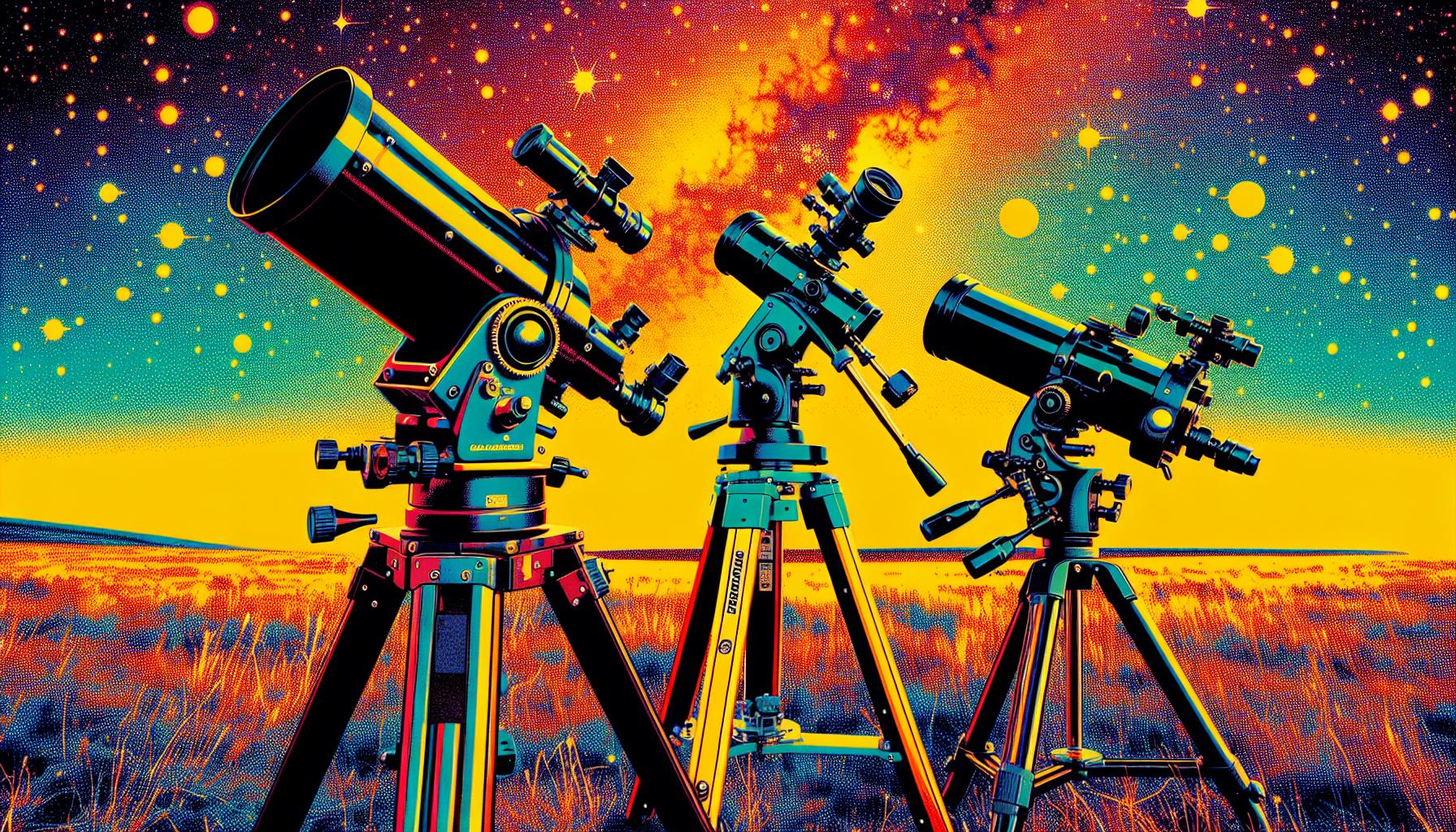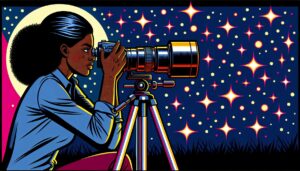This site contains affiliate links to products. I may receive a commission for purchases made through these links.
Embarking on the journey of astrophotography can feel like stepping into a whole new universe. It’s a blend of art and science that’s as fascinating as the celestial bodies you’ll be capturing. A key piece of equipment you’ll need is a beginner astrophotography mount.
Astrophotography mounts are not just your regular tripods. They’re specialized equipment designed to track the motion of stars across the sky. Choosing the right one can make the difference between a blurry mess and a stunning shot of the cosmos.
In the world of astrophotography, the mount is as important as the camera or the telescope. It’s the foundation of your setup, the piece that holds everything together. So, let’s dive into the basics of choosing a beginner astrophotography mount.
What is Astrophotography?
Before we dive deeper into the world of astrophotography mounts, it’s essential to understand the basics of astrophotography itself. Astrophotography is a specialized genre of photography dedicated to capturing astronomical objects and phenomena. It’s not just snapping photos of dazzling stars or captivating constellations. It’s an art form, a pursuit of science, and a journey into the unknown.
Astrophotography can be as simple or as complex as one’s experience, equipment, and ambition allows. From capturing star trails with a basic digital camera to imaging distant galaxies with a high-end telescope setup, the range of this field is vast. The key to astrophotography is patience and a dark sky.
One exciting aspect of astrophotography is its ability to reveal celestial objects and phenomena hardly visible to the naked eye. It’s often surprising that a seemingly empty patch of night sky may hold clusters of far-off galaxies when viewed through a camera or telescope.
Every form of astrophotography, whether it is imaging the Moon, tracking a comet, or capturing a galaxy far, far away, depends heavily on the type of equipment used. High-quality telescopes, cameras, lenses, filters, and of course, mounts, are paramount to capturing the beauty of the universe. Time and exposure settings also have a significant impact on the quality and type of images that can be obtained.
The heart of astrophotography lies in correctly using this myriad of equipment to capture what’s beyond our world. Rather than merely documenting the night sky, astrophotographers lend an artistic touch to scientific discovery. And now that we’ve broadly understood the world of astrophotography, it’s time to dive deeper into its most underrated and non-negotiable aspect: the beginner’s astrophotography mount.
Remember, choosing the right astrophotography mount is as crucial as learning about astrophotography itself, if not more. So let’s go on to understanding what makes for a good beginner’s astrophotography mount.
Importance of a Beginner Astrophotography Mount
It’s unquestionable that astrophotography is made easier and more rewarding with suitable equipment. One of the most critical pieces of equipment for beginners in this field is the astrophotography mount. As a passionate stargazer, seeking those breathtaking portraits of the cosmos, I understand the importance of a solid Astrophotography mount for beginners.
A good mount helps stabilize your camera and telescope, enhancing the quality of your shots. With a dependable mount, beginners find it easier and more convenient to capture the beauty of celestial objects even under less than perfect conditions.
Notably, Astrophotography mounts are not simply standard tripods – they are specialized for viewing and capturing detailed images of astronomical objects. For beginners, having a mount that aligns accurately with the North or South Pole (depending on your location) is vital. The function known as accurate polar alignment optimizes exposure continuity, allowing you to capture long-exposure shots of the stars and galaxies without interruptions.
In the world of astrophotography, there’s a saying: “mount first, telescope second.” You might wonder why? The reason is the quality of your mount often dictates the overall performance and usability of your astrophotography tools. A shaky, unstable, or improperly aligned mount can easily diminish the value of even the most sophisticated telescope.
A beginner astrophotography mount isn’t just about stability and alignment, though. It’s about ushering beginners into the world of astrophotography with minimal frustration and a high degree of success. By having controls that are easier to understand and operate, novice photographers can then focus more on taking breathtaking deep sky objects photos and less on the complicated operation and adjustment of a mount.
These mounts come in various types, each with specific advantages and disadvantages. But understanding their importance is the first step in recognizing their value in your astrophotography journey. So, let’s dive deeper into understanding what makes a good beginner astrophotography mount.
Types of Beginner Astrophotography Mounts
When you’re diving into the world of astrophotography, it’s critical to understand the different types of mounts that are available. I’ll break down the primary types to help you make an informed decision.
Alt-Azimuth Mounts (Alt-Az) are a popular choice for beginners. They’re relatively simple to use and are cost-effective. This type of mount moves in two directions: altitude (up and down) and azimuth (left and right). It’s a great first move if you’re just dipping your toes into astrophotography.
On the other hand, Equatorial Mounts (EQ) offer more advanced features and are ideal for capturing long-exposure shots of stars and constellations. They pivot along a single axis that aligns with Earth’s rotation. This feature compensates for the earth’s movement, allowing you to keep your camera pointed at the same spot in the night sky for extended periods.
Go-To Mounts are an advanced type – these computerized mounts can automatically find and track celestial objects. While they’re an investment, they can significantly improve your images and are an excellent choice if you’re serious about astrophotography.
Here’s a comparison of each type’s features:
| Types of Mounts | Ease of Use | Cost | Best for |
|---|---|---|---|
| Alt-Azimuth | High | Low | Beginners |
| Equatorial | Medium | Medium to High | Advanced Astrophotography |
| Go-To | Low | High | Serious Hobbyists |
But remember, no matter which type of mount you choose, accurate polar alignment and a high-quality mount play a key role in capturing crisp, clear, celestial images.
Key Features to Consider in a Beginner Astrophotography Mount
When you’re starting out in astrophotography, it’s crucial to pick the right mount. Considering the previously discussed types—Alt-Azimuth, Equatorial, and Go-To Mounts—understanding the key attributes of each can help determine which is most suited to your needs.
Quality and Durability should be your main concern. Remember the mount has to withstand varying weather conditions and hold your precious gear securely. A high-grade construction, perhaps from stainless steel or aluminium, with a sturdy design will ensure long-lasting functionality.
Next, let’s talk about Ease of Use. A mount that’s too sophisticated might become a hindrance for a beginner. Alt-Azimuth Mounts, with their straightforward “up-down, left-right” movements, might be the preferred choice here.
The Cost factor can’t be ignored either. While it’s tempting to go for cheap, remember, you’re investing in a hobby that needs sturdy equipment. Between the types we’ve discussed, Alt-Azimuth Mounts tend to be more cost-effective whereas Go-To Mounts come with a higher price tag due to their computerized features.
Consideration should be given to the Tracking Accuracy too. This feature determines how accurately the mount can follow a celestial object as Earth rotates. Equatorial Mounts and Go-To Mounts, with their advanced features, usually outperform Alt-Azimuth mounts in this aspect.
Lastly, think about the Weight Capacity of the mount. Ensure it’s able to support your camera or telescope and additional gear weight. Overloading the mount may impact its performance, potentially causing shaky images.
Here’s a simple comparison of the Beginner Astrophotography Mounts:
| Feature | Alt-Azimuth | Equatorial | Go-To |
|---|---|---|---|
| Quality and Durability | Good | Good | Good |
| Ease of Use | High | Moderate | Moderate to High |
| Cost | $ | $$-$$$ | $$$ |
| Tracking Accuracy | Fair | High | High |
| Weight Capacity | Varies | Varies | Varies |
In the end, there isn’t a one-size-fits-all answer. It’s a personal decision based on your needs, budget and astrophotography goals. Weigh the pros and cons of each type, mindful of their key features, to make an informed decision.
Top Beginner Astrophotography Mounts
Now we’ll highlight the top beginner astrophotography mounts, chosen based on the key factors we’ve discussed: quality and durability, ease of use, cost, tracking accuracy, and weight capacity.
Celestron Advanced VX Mount
First off is the Celestron Advanced VX Mount, known for its sturdy design and ease of use. It’s a quality German equatorial mount with a weight capacity of up to 30 pounds. Its star alignment procedure simplifies the set-up process, making it a great investment for both your pocketbook and your astroimaging journey.
Sky-Watcher EQM-35
The Sky-Watcher EQM-35 delivers impressive tracking accuracy and comes with a price tag that won’t break the bank. It’s specifically designed with beginner astrophotographers in mind, with a weight capacity of 22 pounds. This mount delivers high accuracy for long exposure astroimaging which is crucial in capturing those inspiring astronomical objects.
Orion Atlas EQ-G
The Orion Atlas EQ-G is a heavyweight in our lineup, boasting a load capacity of up to 40 pounds. Despite its heavy-duty performance, it promises user-friendly features and a smooth, stable mount movement. This keeps your scope steady while tracking, critical for taking quality images of deep sky objects.
| Mount | Weight Capacity (pounds) | Tracking Accuracy |
|---|---|---|
| Celestron Advanced VX | 30 | High |
| Sky-Watcher EQM-35 | 22 | High |
| Orion Atlas EQ-G | 40 | High |
Going forward, remember that it’s less about the price tag, and more about the functionality, demands of your telescope, and personal goals in astrophotography that ultimately determine the best mount for you. Which one will you choose?
Conclusion
Choosing the right astrophotography mount for beginners isn’t just about picking the most expensive or the most popular. It’s about finding a balance between quality, durability, ease of use, and cost. The Celestron Advanced VX Mount, Sky-Watcher EQM-35, and Orion Atlas EQ-G each have their strengths and can serve as a great starting point for your astrophotography journey. Remember, the best mount for you will depend on your telescope’s demands and your personal goals in astrophotography. So take your time, do your research, and I’m confident you’ll find the perfect mount to start capturing the stars.
What are the top beginner astrophotography mounts according to the article?
The highlights of the article are the Celestron Advanced VX Mount, Sky-Watcher EQM-35, and the Orion Atlas EQ-G. These mounts are highly recommended based on their quality, durability, ease of use, cost, and tracking accuracy.
Why is the Celestron Advanced VX Mount recommended for beginners?
Celestron Advanced VX Mount is recommended due to its sturdy design and user-friendly interface. This combination makes it a perfect choice for beginners starting out in astrophotography.
What are the key features of the Sky-Watcher EQM-35?
The Sky-Watcher EQM-35 offers impressive tracking accuracy at a comparatively lower price. This makes it an affordable and reliable choice for beginner astrophotographers.
Why is the Orion Atlas EQ-G included in the top mounts list?
The Orion Atlas EQ-G is noted for its high weight capacity. This heavyweight mount can support larger telescopes, making it suitable for those looking at expanding their equipment in the future.
How should one choose the best astrophotography mount?
Choosing the best mount depends on several factors such as its functionality, the demands of the telescope and the astrophotographer’s personal goals. Always consider these factors when comparing options.




